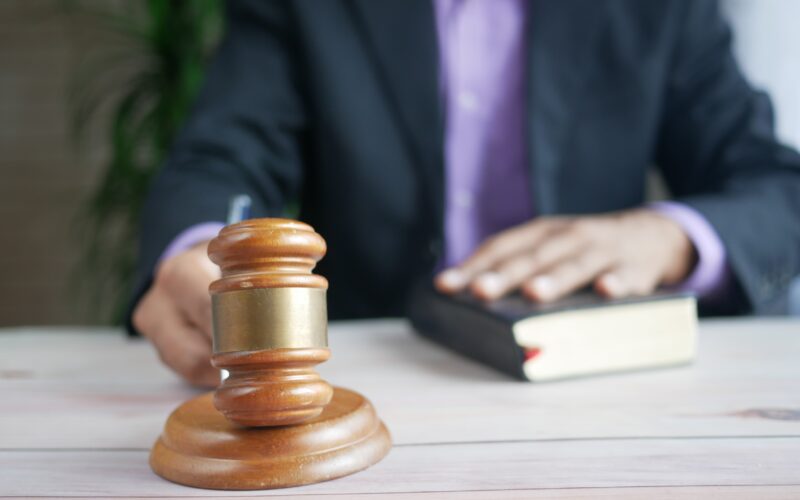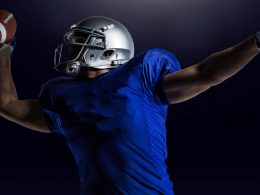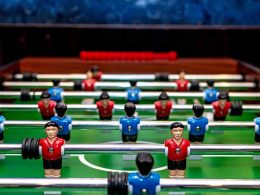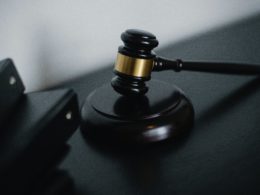Introduction
Almost all National Collegiate Athletic Association (“NCAA”) Division I and Division II schools provide athletic scholarships to their hard working, deserving student athletes. One notable exception is the Ivy League, whose member schools by agreement ban athletic scholarships.1[1]The Ivy League Conference competes in NCAA Division I athletics Arguably, Ivy League athletes are more deserving of these athletic scholarships: they put in the same number of hours on the field and in the weight room, but they dedicate more time to their studies to keep up with the academic rigor of Ivy League coursework. On top of this, the Ivy League schools are amongst the most expensive undergraduate institutions with price tags nearing $90,000 a year.2[2]Stephen Sorace, Cost of Ivy League colleges climb over $80k in 2023, FOX BUSINESS (Mar. 29, 2023, 2:31 PM), https://www.foxbusiness.com/economy/cost-of-ivy-league-colleges-climb-over-80k-2023. This begs the question: why do Ivy League universities withhold athletic scholarships from their student athletes?
This question has come to the forefront in the post NCAA v. Alston era, where the Supreme Court struck down the NCAA’s restrictions on education-related compensation and benefits that universities may offer their athletic recruits.3[3]Nat’l Collegiate Athletic Ass’n v. Alston, 141 S. Ct. 2141 (U.S. 2021). This decision, and Justice Kavanaugh’s scathing concurrence with its famously quoted paragraph,4[4]“Nowhere else in America can businesses get away with agreeing not to pay their workers a fair market rate on the theory that their product is defined by not paying their workers a fair market rate. And under ordinary principles of antitrust law, it is not evident why college sports should be any different. The NCAA is not above the law” Id. at 2169 (Kavanaugh, B., concurring). exemplifies a movement to give student athletes the money and benefits they deserve.
On March 7, 2023, the Ivy League’s ban on athletic scholarships was finally challenged under the antitrust laws in Choh & Kirk v. Brown University et. al.5[5]Complaint, Choh v. Brown Univ., No. 3:23-cv-00305 (D. Conn. filed Mar. 7, 2023). The core claim of this proposed class action6[6]The class would encompass “all Ivy League athletes recruited to play a sport by one or more University Defendants, and who, within the period of March 7, 2019, to the date the conduct challenged as illegal in this Complaint ceases (the “Class Period”) attended one of the University’s undergraduate programs while playing a sport for that school.” Id. at 6-7.is that the defendant Ivy League universities have unlawfully conspired to not pay athletes any compensation for their athletic services in violation of Section 1 of the Sherman Antitrust Act.7[7]15 U.S.C. §1; Complaint, supra note 5, at 6.The suit seeks a permanent injunction, enjoining Ivy League universities from continuing this practice, and damages dating back to March 7, 2019.8[8]Id. at 6-7.
The article explores the history of the Ivy League’s ban on athletic scholarships, the antitrust claims advanced in Choh v. Brown, and the legal implications for the future of Ivy League athletics.
Factual Background
Before analyzing Choh’s antitrust claims, it is important to understand the history of the Ivy League’s ban on athletic scholarships. The Ivy League athletic conference, comprised of the “ancient eight”9[9]The “ancient eight” is a misnomer, since only seven of the universities, all except Cornell University, were nine of the colonial colleges established in America prior to the signing of the Declaration of Independence. Moses Colt Tyler, Prof. at Cornell Univ., Colleges in Colonial Times (Apr. 20, 1883) (transcript found at https://www.thecrimson.com/article/1883/4/20/colleges-in-the-colonial-times-prof/). universities,10[10]Its members include Brown University, Columbia University, Cornell University, Dartmouth College, Harvard University, Princeton University, University of Pennsylvania, and Yale University. About the Ivy League, IVY LEAGUE, https://ivyleague.com/sports/2017/8/13/HISTORY_0813173057.aspx (last visited Apr. 26, 2023). was founded in 1954 with the Ivy League Agreement11[11]THE IVY LEAGUE AGREEMENT (1954) (available at https://admissions.dartmouth.edu/glossary-term/ivy-league-agreement). More accurately though, the first Ivy League Agreement was signed in 1945 though it only applied to football. 9 years after, in 1954, it was applied to all intercollegiate sports offered by Ivy League universities and thus is considered the foundation of the Ivy League conference. A History of Tradition, IVY LEAGUE, https://ivyleague.com/sports/2017/7/28/history-timeline-index.aspx (last visited Apr. 26, 2023).. Under this Agreement, the eight university presidents, later named “Council of Ivy Group Presidents,”12[12]Id. agreed “[a]ll the Ivy institutions follow the common policy that any financial aid for student-athletes will be awarded and renewed on the sole basis of economic need with no differentiation in amount or in kind (e.g. packaging) based on athletic ability or participation….”13[13]THE IVY LEAGUE AGREEMENT, supra note 12.
In addition to the Ivy League Agreement, the Ivy League universities (plus MIT, called the “Ivy Overlap Group”) further agreed to “use common principles to assess each student’s financial need and to give essentially the same financial aid award to students admitted to more than one member of the group.”14[14] H.R. Rep. No. 105-144, at 2 (1997). This principle applied to all students including athletes, and potentially eliminates competition among the member schools to recruit students based on their financial aid packages.
This practice went undisturbed from the 1950s until the late 1980s when the Antitrust Division of the Department of Justice sued the Ivy Overlap Group in 1989 claiming a violation of federal antitrust laws.15[15]Id.This lawsuit resulted in the eight Ivy League universities agreeing to a consent decree to end the practice.16[16]Id. But in 1992, Congress passed a temporary antitrust exemption that allowed them to continue equalizing financial aid packages, although on a need-blind basis.17[17]Id. This exemption was extended and broadened by the Improving America’s Schools Act of 199418[18]Id. at 3; Improving America’s Schools Act of 1994, §568, Pub. L. No. 103–382, 108 Stat. 3518, 4060 (1994). and further extended four more times.19[19]Need-Based Educational Aid Antitrust Protection Act of 1997, Pub. L. No. 105-43 (1997); The Need-Based Educational Aid Act of 2001, Pub. L. No. 107-72, 115 Stat. 648 (2001); The Need-Based Educational Aid Act of 2015, Pub. L. No. 114-44 (2015). Therefore, since 1992, the Ivy League universities (among others, named the “568 Presidents Group”20[20]In 1998, the 568 Presidents Group was formed taking their name from the Section 568 exemption. It initially included 28 universities, though now includes 17. “The 568 Presidents Group members share a common methodology to calculate need-based financial aid packages.” This group has been argued to be anticompetitive in violation of federal antitrust laws without the antitrust exemption. Anika Seth, Lawsuit challenges Ivy refusal to offer athletic scholarships, YALE DAILY NEWS (Mar. 8, 2023, 12:32 AM), , https://yaledailynews.com/blog/2023/03/08/lawsuit-challenges-ivy-refusal-to-offer-athletic-scholarships/.)enjoyed an antitrust exemption. That was, until September 30, 2022, when the most-recent extension expired without congressional renewal.21[21]The Need-Based Educational Aid Act of 2015, Pub. L. No. 114-44 (2015).
Ahead of antitrust exemption’s expiration, two attorneys, Alan Cotler and Robert Litan, sent the Ivy Group Presidents a memo advising of a potential challenge to the schools continuing to ban athletic scholarships, arguing the practice was incompatible with the Alston opinion. 22[22]Alan Cotler & Robert Litan, Decision time for the Ivy League: What the NCAA v. Alston Supreme Court decision means for the Ivy League’s policy of not providing athletic scholarships, IVY HOOPS ONLINE (July 25, 2021), https://ivyhoopsonline.com/2021/07/25/decision-time-for-the-ivy-league-what-the-ncaa-v-alston-supreme-court-decision-means-for-the-ivy-leagues-policy-of-not-providing-athletic-scholarships/ (the authors also published this article in addition to submitting the memo to the Ivy Group Presidents). Those same attorneys filed the Choh lawsuit in early 2023.23[23]Complaint, supra note 5, at 6.
Antitrust Analysis of Choh & Kirk v. Brown University et. al.
The complaint alleges the Ivy League Agreement violates §1 of the Sherman Antitrust Act by illegally fixing the price to recruit student athletes.24[24]Id.; 15 U.S.C. §1. There are actually two parts to their argument: the financial aid (antitrust exemption) and the compensation (similar to Alston) parts. “Distinguishing between the financial aid argument and the athlete compensation argument is important because Section 568 only applied to financial aid price fixing, not the refusal to compensate. If the court decides that the universities were truly need-blind, they would not be liable for historical damages under antitrust law. However, even then, the plaintiffs could still hope to win their case — and historical damages under this lawsuit — on the compensation framework.” Seth, supra note 21. To further complicate their argument, the complaint also alleges that Section 568 never apply to the Ivy League schools because their financial aid was never need-blind. Complaint, supra note 5, at 52-53. It claims the Ivy League universities are horizontal competitors in two distinct, though related markets: “(1) the market for educational services for athletically and academically high-achieving (“AAHA”) students who seek to graduate from college and play Division 1 sports in the [NCAA], and (2) the market for the athletic services of the AAHA students who seek to play for the University Defendants.”25[25]Id. at 3.
Plaintiffs first allege the Ivy League Agreement is per se illegal. “Absent the Ivy League Agreement, these schools would determine unilaterally, and in competition with each other, how many athletic scholarships to provide, by sport, and in what amounts, and how much to compensate (either directly or through reimbursement of tuition, room, and board, or both) for athletic services.”26[26]Id. at 2. Per the complaint, the per se standard developed in United States v. Brown University27[27]U.S. v. Brown Univ., 5 F.3d 568 (3d Cir. 1992).is satisfied as these athletic operations are both commercial enterprises and not purely altruistic, instead seeking to maximize revenue, and because “market realities”28[28]Plaintiffs rely on the “market realities” idea that the Supreme Court found relevant in their NCAA v. Alston analysis. Alston, 141 S. Ct. at 2158. have changed.29[29]Complaint, supra note 5, at 29-43.
While plaintiffs may be correct the Brown standard is met, the Supreme Court has been reluctant to condemn sports industry restraints as per se illegal because of “sports exceptionalism.”30[30]See, e.g., Alston, 141 S. Ct. at 2157; NCAA v. Board of Regents of the Univ. of Okla., 468 U.S. 85, 100-02 (1984). Specifically as applied to the NCAA, the Supreme Court in Alston quoted from NCAA v. Board of Regents where “[t]he Court declined to declare the NCAA’s restraints per se unlawful only because they arose in an industry in which some horizontal restraints on competition are essential if the product is to be available at all.”31[31]Alston, 141 S. Ct. at 2157 (quoting Board of Regents, 468 U.S. at 101-02) (internal quotations omitted). Instead, both Courts decided to use a shortened form of rule of reason analysis, a “quick look.”32[32]Board of Regents, 468 U.S. at 109, n.39; Alston, 141 S. Ct. at 2157. Thus, it is likely a court would instead use a “quick look” analysis in the given case instead of declaring the Ivy League’s restraints per se illegal.
Second, the complaint alleges that, even under a rule-of-reason analysis, the Ivy League holds both monopoly and monopsony market power in the above-described United States markets as the “dominant providers of educational services of AAHA students and purchasers of AAHA students’ athletic services.”33[33]Complaint, supra note 5, at 49. Thus, the Ivy League Agreement has anticompetitive effects by suppressing competition in these markets with no adequate substitutes in non-Ivy League, athletic-scholarship-offering schools (such as Duke, Notre Dame, Georgetown, Stanford, and Rice).34[34]Id. at 47.
Further, the complaint argues there are no procompetitive justifications, specifically rebutting some anticipated justifications.35[35]Id. at 50-52. Plaintiffs claim the Ivy League Agreement is not necessary to: (1) “permit University Defendants to field teams in large numbers of intercollegiate sports”;36[36]Id. at 50.(2) “assure competitive balance in athletics among University Defendants”;37[37]Id. (3) “maintain or enhance academic excellence of University Defendants”;38[38]Id. and (4) “allow University Defendants to provide financial aid, need based or merit, to non-AAHA students” (given their sufficient resources from their individual billion dollar endowments).39[39]Id. at 51. Plaintiffs’ counsel recently stated “The Ivy League agreement is particularly egregious given the huge amounts of money these schools have in their endowments… Where hundreds of Division I schools with much fewer resources compete without limits on athletic scholarships and compensation or reimbursement, the Ivy League schools have no excuse for not doing the same.” Seth, supra note 21. Lastly, the complaint argues a less restrictive alternative exists if the University Defendants “simultaneously maintain or enhance their academic excellence through agreement on minimum or average academic admissions standards, or both.”40[40]Complaint, supra note 5, at 52.
In response to the filing, parties (both those interested and not) have voiced various procompetitive justifications (other than those anticipated in the complaint), including “Ivy League student athletes are not a market that antitrust law ought to protect,”41[41]Michael McCann, Ivy League Scholarship Ban Under Fire in Basketballers’ Suit, SPORTICO (Mar. 8, 2023, 10:26 AM), https://www.sportico.com/law/analysis/2023/ivy-league-lawsuit-athletic-scholarships-1234711788/. “athletes are free to attend other colleges that offer solid athletic programs and impressive academics,”42[42]Id. Executive Director of the Ivy League, Robin Harris, released a statement in response to the Choh v. Brown lawsuit that reiterated this point: “As students and their families consider the higher education and, specifically, the intercollegiate athletics opportunities available to them, there are a wide variety of options. Each choice, including the Ivy League, represents an individual decision and carries its own distinct features and benefits.” Mike Jensen, Federal lawsuit takes aim at Ivy League’s policy of no athletic scholarships, PHILA. INQUIRER (Mar. 7, 2023), https://www.inquirer.com/college-sports/penn/ivy-league-ncaa-lawsuit-athletic-scholarships-20230307.html. Ivy League schools don’t have enough resources to pay for athletic scholarships and the money should go elsewhere,43[43] This argument was a big part of the Overlap Group’s Department of Justice Lawsuit. One of plaintiff’s attorneys, Robert Litan, was quoted saying “I did not believe that argument was valid at the time. These were rich schools then; they are much richer now.” Currently, the Ivy League schools have a combined endowment of over $170 billion. Id. and the need to preserve the prestigious academic environments offered by these institutions.44[44]Id.
While the procompetitive justifications of the rule of reason analysis would be subject to the fact finder’s determination, the market definition may be outcome determinative. In Alston, the Supreme Court discussed the district court’s finding that the “injunction applied only to the NCAA and multiconference agreements; individual conferences remain free to reimpose every single enjoined restraint tomorrow -or more restrictive ones still.”45[45]Alston, 141 S. Ct. at 2164. If the Choh courtadopts this dicta, the Ivy League would be free to continue imposing tighter restrictions on compensation and benefits than the NCAA under Alston, without incurring antitrust liability. But, in their pre-lawsuit memo to the Ivy Group Presidents, plaintiffs’ counsel argued that “[i]f one [] reads the opinion too quickly, it may appear that the Court’s holding gives the Ivies a pass…But that outcome does not make sense: the NCAA cannot impede competition…but the Ivy League can? Indeed, on the very next page of its opinion, all the Justices made clear that they were not addressing or opining on that part of the trial court’s order…,” instead confining their review to those enjoined restrictions.46[46]Cotler & Litan, supra note 23. Thus, the Alston decision provides an unclear answer and begs further Supreme Court opinion.
The case and now a motion to dismiss, filed May 15, 2023, is currently before Judge Alvin Thompson in the U.S. District Court of Connecticut.47[47]Mem. in Supp. of Defs. Mot. to Dismiss, Choh v. Brown Univ., No. 3:23-cv-00305 (D. Conn. filed May 15, 2023). In support of that motion, defendants argue that plaintiffs have not plausibly alleged a per se antitrust violation, have failed to state a claim under the rule of reason, have failed to plausibly allege antitrust injury-in-fact, and have named a plaintiff—Choh—whose claim is barred by the statute of limitations.48[48]Id.Defendants further argue that plaintiffs have not identified a plausible product market and, even if they have, plaintiffs have failed to show that defendants have “requisite power within the market to harm competition” or “the regulation has had direct anticompetitive effects on the market as a whole.”49[49]Id. at 2-3. If Judge Thompson believes the complaint contains sufficient subject matter that, accepted as true, states a claim that is plausible on its face,50[50]Ashcroft v. Iqbal, 556 U.S. 678 (2009); Bell Atl. Corp. v. Twombly, 550 U.S. 544 (2007). the motion to dismiss will be denied and the case will proceed to discovery.
Conclusion
Choh’s challenge of Ivy League universities’ ban on athletic scholarships pokes at the holes left by Alston and has the potential to further the student-athlete rights movement. While the Choh litigation progresses, other ongoing cases could impact Ivy League athletes and their compensation. Those cases include Johnson v. NCAA seeking employee status for student-athletes under the Fair Labor Standards Act;51[51]Richard Johnson, Explaining Johnson v. NCAA and What’s at Stake in Wednesday’s Court Hearing, SPORTS ILLUSTRATED (Feb. 15, 2023), https://www.si.com/college/2023/02/15/johnson-v-ncaa-court-hearing-employment-status (the case, currently before the 3rd Circuit, explores whether college athletes are employees under the Fair Labor Standards Act). an antitrust challenge to the financial aid price-fixing alleged against the 568 Presidents Group;52[52]Jordan Fitzgerald, Yale sued for violating antitrust law by considering financial need in admissions, YALE DAILY NEWS (Feb. 16, 2022, 12:09 AM), https://yaledailynews.com/blog/2022/02/16/yale-sued-for-violating-antitrust-law-by-considering-financial-need-in-admissions/.the National Labor Relations Board weighing whether college athletes should be considered employees under the National Labor Relations Act;53[53]Dan Murphy, NLRB to pursue unlawful labor practices against USC, Pac-12, and NCAA, ESPN (Dec. 15, 2022), https://www.espn.com/college-football/story/_/id/35259868/nlrb-pursue-unlawful-labor-practices-usc-pac-12-ncaa.and a lawsuit arguing Harvard’s admissions policy violates the Civil Rights Act of 1964.54[54]Students for Fair Admissions (SFFA) v. Harvard, LAWYER’S COMM. FOR CIV. RTS. UNDER L., https://www.lawyerscommittee.org/students-for-fair-admissions-sffa-v-harvard/ (last visited Apr. 26, 2023). Just as “the NCAA is not above the law,”55[55]Alston, 141 S. Ct. at 2169 (Kavanaugh, B., concurring). neither is the Ivy League.
Written by: Francesca Casalino
Francesca is a 2023 J.D. Candidate at Brooklyn Law School
1 The Ivy League Conference competes in NCAA Division I athletics.
2 Stephen Sorace, Cost of Ivy League colleges climb over $80k in 2023, Fox Business (Mar. 29, 2023, 2:31 PM), https://www.foxbusiness.com/economy/cost-of-ivy-league-colleges-climb-over-80k-2023.
3 Nat’l Collegiate Athletic Ass’n v. Alston, 141 S. Ct. 2141 (U.S. 2021).
4 “Nowhere else in America can businesses get away with agreeing not to pay their workers a fair market rate on the theory that their product is defined by not paying their workers a fair market rate. And under ordinary principles of antitrust law, it is not evident why college sports should be any different. The NCAA is not above the law” Id. at 2169 (Kavanaugh, B., concurring).
5 Complaint, Choh v. Brown Univ., No. 3:23-cv-00305 (D. Conn. filed Mar. 7, 2023).
6 The class would encompass “all Ivy League athletes recruited to play a sport by one or more University Defendants, and who, within the period of March 7, 2019, to the date the conduct challenged as illegal in this Complaint ceases (the “Class Period”) attended one of the University’s undergraduate programs while playing a sport for that school.” Id. at 6-7.
7 15 U.S.C. §1; Complaint, supra note 5, at 6.
8 Id. at 6-7.
9 The “ancient eight” is a misnomer, since only seven of the universities, all except Cornell University, were nine of the colonial colleges established in America prior to the signing of the Declaration of Independence. Moses Colt Tyler, Prof. at Cornell Univ., Colleges in Colonial Times (Apr. 20, 1883) (transcript found at https://www.thecrimson.com/article/1883/4/20/colleges-in-the-colonial-times-prof/).
10 Its members include Brown University, Columbia University, Cornell University, Dartmouth College, Harvard University, Princeton University, University of Pennsylvania, and Yale University. About the Ivy League, Ivy League, https://ivyleague.com/sports/2017/8/13/HISTORY_0813173057.aspx (last visited Apr. 26, 2023).
11 The Ivy League Agreement (1954) (available at https://admissions.dartmouth.edu/glossary-term/ivy-league-agreement). More accurately though, the first Ivy League Agreement was signed in 1945 though it only applied to football. 9 years after, in 1954, it was applied to all intercollegiate sports offered by Ivy League universities and thus is considered the foundation of the Ivy League conference. A History of Tradition, Ivy League, https://ivyleague.com/sports/2017/7/28/history-timeline-index.aspx (last visited Apr. 26, 2023).
12 Id.
13 The Ivy League Agreement, supra note 12.
14 H.R. Rep. No. 105-144, at 2 (1997).
15 Id.
16 Id.
17 Id.
18 Id. at 3; Improving America’s Schools Act of 1994, §568, Pub. L. No. 103–382, 108 Stat. 3518, 4060 (1994).
19 Need-Based Educational Aid Antitrust Protection Act of 1997, Pub. L. No. 105-43 (1997); The Need-Based Educational Aid Act of 2001, Pub. L. No. 107-72, 115 Stat. 648 (2001);The Need-Based Educational Aid Act of 2015, Pub. L. No. 114-44 (2015).
20 In 1998, the 568 Presidents Group was formed taking their name from the Section 568 exemption. It initially included 28 universities, though now includes 17. “The 568 Presidents Group members share a common methodology to calculate need-based financial aid packages.” This group has been argued to be anticompetitive in violation of federal antitrust laws without the antitrust exemption. Anika Seth, Lawsuit challenges Ivy refusal to offer athletic scholarships, Yale Daily News (Mar. 8, 2023, 12:32 AM), https://yaledailynews.com/blog/2023/03/08/lawsuit-challenges-ivy-refusal-to-offer-athletic-scholarships/.
21 The Need-Based Educational Aid Act of 2015, Pub. L. No. 114-44 (2015).
22 Alan Cotler & Robert Litan, Decision time for the Ivy League: What the NCAA v. Alston Supreme Court decision means for the Ivy League’s policy of not providing athletic scholarships, Ivy Hoops Online (July 25, 2021), https://ivyhoopsonline.com/2021/07/25/decision-time-for-the-ivy-league-what-the-ncaa-v-alston-supreme-court-decision-means-for-the-ivy-leagues-policy-of-not-providing-athletic-scholarships/ (the authors also published this article in addition to submitting the memo to the Ivy Group Presidents).
23 Complaint, supra note 5, at 6.
24 Id.; 15 U.S.C. §1. There are actually two parts to their argument: the financial aid (antitrust exemption) and the compensation (similar to Alston) parts. “Distinguishing between the financial aid argument and the athlete compensation argument is important because Section 568 only applied to financial aid price fixing, not the refusal to compensate. If the court decides that the universities were truly need-blind, they would not be liable for historical damages under antitrust law. However, even then, the plaintiffs could still hope to win their case — and historical damages under this lawsuit — on the compensation framework.” Seth, supra note 21. To further complicate their argument, the complaint also alleges that Section 568 never apply to the Ivy League schools because their financial aid was never need-blind. Complaint, supra note 5, at 52-53.
25 Id. at 3.
26 Id. at 2.
27 U.S. v. Brown Univ., 5 F.3d 568 (3d Cir. 1992).
28 Plaintiffs rely on the “market realities” idea that the Supreme Court found relevant in their NCAA v. Alston analysis. Alston, 141 S. Ct. at 2158.
29 Complaint, supra note 5, at 29-43.
30 See, e.g., Alston, 141 S. Ct. at 2157; NCAA v. Board of Regents of the Univ. of Okla., 468 U.S. 85, 100-02 (1984).
31 Alston, 141 S. Ct. at 2157 (quoting Board of Regents, 468 U.S. at 101-02) (internal quotations omitted).
32 Board of Regents, 468 U.S. at 109, n.39; Alston, 141 S. Ct. at 2157.
33 Complaint, supra note 5, at 49.
34 Id. at 47.
35 Id. at 50-52.
36 Id. at 50.
37 Id.
38 Id.
39 Id. at 51. Plaintiffs’ counsel recently stated “The Ivy League agreement is particularly egregious given the huge amounts of money these schools have in their endowments… Where hundreds of Division I schools with much fewer resources compete without limits on athletic scholarships and compensation or reimbursement, the Ivy League schools have no excuse for not doing the same.” Seth, supra note 21.
40 Complaint, supra note 5, at 52.
41 Michael McCann, Ivy League Scholarship Ban Under Fire in Basketballers’ Suit, Sportico (Mar. 8, 2023, 10:26 AM), https://www.sportico.com/law/analysis/2023/ivy-league-lawsuit-athletic-scholarships-1234711788/.
42 Id. Executive Director of the Ivy League, Robin Harris, released a statement in response to the Choh v. Brown lawsuit that reiterated this point: “As students and their families consider the higher education and, specifically, the intercollegiate athletics opportunities available to them, there are a wide variety of options. Each choice, including the Ivy League, represents an individual decision and carries its own distinct features and benefits.” Mike Jensen, Federal lawsuit takes aim at Ivy League’s policy of no athletic scholarships, Phila. Inquirer (Mar. 7, 2023), https://www.inquirer.com/college-sports/penn/ivy-league-ncaa-lawsuit-athletic-scholarships-20230307.html.
43 This argument was a big part of the Overlap Group’s Department of Justice Lawsuit. One of plaintiff’s attorneys, Robert Litan, was quoted saying “I did not believe that argument was valid at the time. These were rich schools then; they are much richer now.” Currently, the Ivy League schools have a combined endowment of over $170 billion. Id.
44 Id.
45 Alston, 141 S. Ct. at 2164.
46 Cotler & Litan, supra note 23.
47 Mem. in Supp. of Defs. Mot. to Dismiss, Choh v. Brown Univ., No. 3:23-cv-00305 (D. Conn. filed May 15, 2023).
48 Id.
49 Id. at 2-3.
50 Ashcroft v. Iqbal, 556 U.S. 678 (2009); Bell Atl. Corp. v. Twombly, 550 U.S. 544 (2007).
51 Richard Johnson, Explaining Johnson v. NCAA and What’s at Stake in Wednesday’s Court Hearing, Sports Illustrated (Feb. 15, 2023), https://www.si.com/college/2023/02/15/johnson-v-ncaa-court-hearing-employment-status (the case, currently before the 3rd Circuit, explores whether college athletes are employees under the Fair Labor Standards Act).
52 Jordan Fitzgerald, Yale sued for violating antitrust law by considering financial need in admissions, Yale Daily News (Feb. 16, 2022, 12:09 AM), https://yaledailynews.com/blog/2022/02/16/yale-sued-for-violating-antitrust-law-by-considering-financial-need-in-admissions/.
53 Dan Murphy, NLRB to pursue unlawful labor practices against USC, Pac-12, and NCAA, ESPN (Dec. 15, 2022), https://www.espn.com/college-football/story/_/id/35259868/nlrb-pursue-unlawful-labor-practices-usc-pac-12-ncaa.
54 Students for Fair Admissions (SFFA) v. Harvard, Lawyer’s Comm. For Civ. Rts. Under L., https://www.lawyerscommittee.org/students-for-fair-admissions-sffa-v-harvard/ (last visited Apr. 26, 2023).
55 Alston, 141 S. Ct. at 2169 (Kavanaugh, B., concurring).




